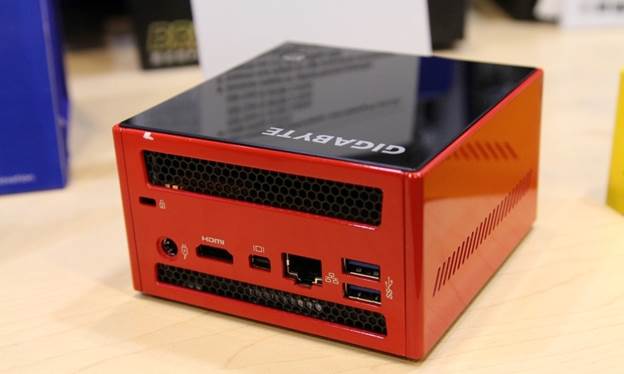The miniature BRIX Gaming gives you the performance you’ve come to
expect from a larger rig.
“This system is a great companion for anyone’s TV,” adds
Chen. Realtek’s ALC269 codec supplies the BRIX Gaming’s sound capabilities, and
you’ll be able to deliver those sounds over the HDMI and mini DisplayPort
outputs, as well as a headphone jack.
Connectivity
The BRIX Gaming is no slouch when it comes to wired and
wireless connectivity. GIGABYTE has smartly added a mini PCI-E wireless module
to the PC (located below the BRIX Gaming’s mSATA connector), giving it wireless
connectivity for both Bluetooth 4.0 and 802.11a/b/g/n/ ac. “We opted for these
wireless connections as Bluetooth is becoming more widely used in mobile
devices,” says Chen. “We chose to include Wi-Fi as not everyone’s home theater
system has wired [network] connectivity.”

One benefit to the
Brix is that most models come with a VESA mounting bracket
For wired connectivity, the front panel offers a headphone
output and two USB 3.0 ports, while the rear panel offers two more USB 3.0
ports, an Ethernet port, and the HDMI and mini DisplayPort video outputs. Those
concerned about the security of the miniature gaming system will like that
GIGABYTE includes a Kensington lock slot.
What You’ll Need To Add
The BRIX Gaming is a barebones system that gives you the
flexibility to select your own SO-DIMM memory, system storage, and operating
system. “We know that consumers use systems differently and they all have
different preferences,” says Chen. “We sell it barebone to allow consumers to
be able to customize and upgrade.”

the memory section
with two SO-DIMMs slot
For memory, the BRIX Gaming provides you with two SO-DIMM slots
that together can handle up to 16GB of DDR3L (1.35V) clocked at 1,333MHz or
1,600MHz. The low-voltage memory should produce less heat than 1.5V DDR3
SO-DIMMs, which is helpful considering the BRIX Gaming’s tiny enclosure.
For storage, you can use a 2.5-inch drive, as well as an
mSATA SSD. These storage options give you some freedom to customize the BRIX
Gaming according to your performance and capacity needs. For instance, HTPC
builders can install an mSATA SSD as a boot drive and use a large 2.5-inch hard
drive to provide the necessary capacity for HD videos and large music
collections. Gamers, on the other hand, may opt for a single 2.5- inch SSD that
has enough storage for their favorite titles. Whatever your preference, it’s
nice that you can make choices for the memory and storage that fit your budget,
rather than being forced to use a preset configuration.
Power Options
GIGABYTE locates the power button on top of the unit, but
you’re also able to configure the BRIX Gaming to turn on through a connected
USB keyboard or mouse. (This feature was only available to Windows 8 systems at
the time of this writing.) This is ideal if you’ve placed the BRIX Gaming
behind an HDTV or monitor, where it would be inconvenient to reach every time
you want to turn it on. To set up the USB power, just press F2 or DEL during
startup to enter the BIOS. Then, choose Chipset, select the ErP option, and
choose Disabled. Save and exit the BIOS. Then, install the USB Power-On Patch
for Windows 8, which you can find in a folder of the same name on the BRIX
Gaming’s driver CD. Your system can now power on at the press of a key.

The miniature BRIX
Gaming gives you the performance
you’ve come to expect from a larger rig.
BRIX Strength
We can’t imagine a full-fledged gaming PC that’s
smaller than the BRIX Gaming, and it’s more than just a gamer. It can also
function as a capable HTPC. We particularly like the ability to mount the
system to the back of any HDTV with a VESA mount, as you won’t even need an
entertainment center or audio cabinet to conceal it, plus its extensive
wireless networking support lets you install it virtually anywhere without
worrying about the need to make a cable connection. Now, we just need some sort
of collapsible monitor so we can fit an entire gaming rig in a backpack.